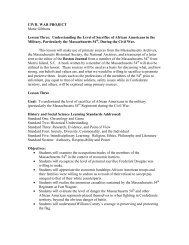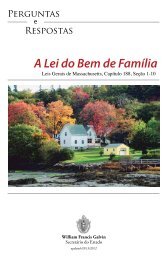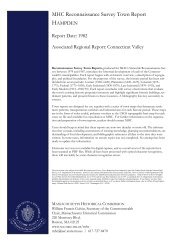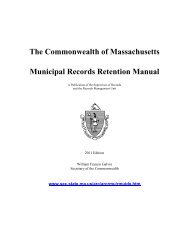Roads, Rails, and Trails - Secretary of the Commonwealth
Roads, Rails, and Trails - Secretary of the Commonwealth
Roads, Rails, and Trails - Secretary of the Commonwealth
Create successful ePaper yourself
Turn your PDF publications into a flip-book with our unique Google optimized e-Paper software.
THE POLPIS ROAD BICYCLE PATH SITES, NANTUCKET<br />
The Polpis Road Bicycle Path runs just over eight miles<br />
through <strong>the</strong> eastern part <strong>of</strong> Nantucket Isl<strong>and</strong>, from <strong>the</strong> center <strong>of</strong><br />
Nantucket to <strong>the</strong> village <strong>of</strong> Siasconset. The path follows Polpis<br />
Road, but is separated from it to make bicycle travel much<br />
safer.<br />
Nantucket, Massachusetts<br />
An archaeological study <strong>of</strong> <strong>the</strong> proposed bicycle path<br />
route was done in 1989 by <strong>the</strong> Public Archaeology Laboratory,<br />
Inc. (PAL). Background research <strong>and</strong> preliminary testing<br />
identified thirty-six archaeological sites or “findspots” (isolated<br />
items or scatters <strong>of</strong> a few artifacts) along <strong>the</strong> route. Not all <strong>of</strong><br />
<strong>the</strong> thirty-six warranted fur<strong>the</strong>r investigation; PAL<br />
recommended eight sites for excavation or avoidance.<br />
Avoidance could be difficult. It was not always easy to find a<br />
new route, for example when <strong>the</strong> road ran right next to a<br />
wetl<strong>and</strong> <strong>the</strong>re was little choice in where to run <strong>the</strong> bicycle path.<br />
27<br />
Eventually, in 1991, PAL under <strong>the</strong> direction <strong>of</strong><br />
archaeologist Mary Lynne Rainey, excavated four important<br />
sites that could not be avoided. These were <strong>the</strong> first<br />
pr<strong>of</strong>essional research-oriented digs ever done on Nantucket.<br />
Two <strong>of</strong> <strong>the</strong> sites will be discussed below: sites 19-NT-50 <strong>and</strong><br />
19-NT-68.<br />
Agreed, <strong>the</strong>se sites don’t exactly have <strong>the</strong> most<br />
interesting or evocative names. But <strong>the</strong> archaeological study <strong>of</strong><br />
<strong>the</strong> sites produced very interesting information about centuries<br />
<strong>of</strong> Native American life on Nantucket before <strong>and</strong> shortly after<br />
<strong>the</strong> arrival <strong>of</strong> European settlers. The sites were named<br />
according to a system that <strong>the</strong> Smithsonian Institution<br />
developed during <strong>the</strong> 1940s to give every archaeological site in<br />
<strong>the</strong> United States a unique designation that would also indicate<br />
its location. The first part <strong>of</strong> <strong>the</strong> number—19 in this case—<br />
st<strong>and</strong>s for <strong>the</strong> state. Massachusetts was nineteenth<br />
alphabetically (before Alaska <strong>and</strong> Hawaii were added). The<br />
second part—NT—is a county code, in this case Nantucket.<br />
The last part just numbers <strong>the</strong> sites from one to whatever as<br />
new sites are reported. So <strong>the</strong>se site “names” actually contain<br />
some basic information, though <strong>the</strong>y may lack poetry. The sites<br />
were <strong>the</strong> fiftieth <strong>and</strong> sixty-eighth sites to be reported from<br />
Nantucket County, Massachusetts.<br />
The two sites were found in different areas along <strong>the</strong><br />
route <strong>of</strong> <strong>the</strong> path. But both were in similar kinds <strong>of</strong> locations<br />
<strong>and</strong> both contained <strong>the</strong> remnants <strong>of</strong> a Native American<br />
dwelling. The excavation methods were somewhat unusual.<br />
The archaeologists established a grid over <strong>the</strong> sites <strong>and</strong><br />
excavated several one- or two-meter squares (about 10% <strong>of</strong> <strong>the</strong><br />
site area) with h<strong>and</strong> tools, screening all soils through wire mesh<br />
to recover small items, recording <strong>the</strong> precise locations <strong>of</strong>








